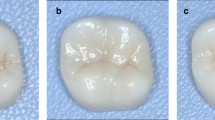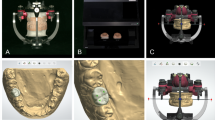Abstract
A stable centric occlusal position that shows no evidence of occlusal disease should not be altered. Confirmative restorative dentistry deals with making restorations that are in harmony with existing jaw relations. Conventional techniques for construction have been unsuccessful in producing a prosthesis that can be inserted without minor intraoral occlusal adjustment. This study was conducted to evaluate the benefits of the double casting technique with FGP over the conventional casting technique. Ten patients with root canal treated maxillary molar were selected for the fabrication of metal crown. Two techniques, one involving the conventional fabrication and other using functionally generated path with double casting were used to fabricate the prosthesis. A comparison based on various parameters which was done between the two techniques. The change in the height of castings for the double casting group was less compared to the conventional group and was highly statistically significant (P < 0.001). The time taken for occlusal correction was significantly lower in double casting group than the conventional group (P < 0.001). The patient satisfaction (before occlusal correction) indicated better satisfaction for double casting group compared to conventional (P < 0.01). The functionally generated path with double casting technique resulted in castings which had better dimensional accuracy, less occlusal correction and better patient satisfaction compared to the conventional castings.





Similar content being viewed by others
References
Celenza FV, Litvak H (1976) Occlusal management in conformative dentistry. J Prosthet Dent 36:164–170
Minagi S, Tanaka T, Sato T, Matsunaga T (1998) Double casting method for fixed prosthodontics with functionally generated path. J Prosthet Dent 79:120–124
Kim KS, Neitzki C (2008) Applying functionally generated path to restore a terminal restoration in group function. Clin Update 30:125–128
Meyer FS (1959) The generated path technique in reconstruction dentistry. Part I: complete dentures. J Prosthet Dent 9(3):354–366
Meyer FS (1959) The generated path technique in reconstruction dentistry. Part II. Fixed partial dentures. J Prosthet Dent 9(3):432–440
Kafandaris NM (1981) A modified functionally generated path technique for making maxillary posterior ceramometal restorations. J Prosthet Dent 46(1):29–31
Mann AW, Pankey LD (1959) Oral rehabilitation utilizing the Pankey-Mann Instrument and a functional bite technique. Dent Clin North Am 3:215–230
Mann AW, Pankey LD (1963) Concepts of occlusion. The P.M. philosophy of occlusal rehabilitation. Dent Clin North Am 7:621–636
Sutton AJ, Sheets DW Jr, Ford DE (2003) Fabrication of a functionally generated, implant-retained fixed partial denture. J Prosthodont 12:260–264
Dawson PE (1989) Evaluation, diagnosis and treatment of occlusal problems, 2nd Edition edn. The C.V. Mosby Company, St.Louis, pp 410–433
Shillingburg HT, Hobo S, Whitsett LD, Jacobi R, Brackett SE (1997) Fundamentals of fixed prosthodontics, 3rd edn. Quintessence Publishing Co., Inc, Chicago, pp 355–364
Zimmermann EM (1966) Modifications of functionally generated path procedures. J Prosthet Dent 16:1119–1126
Rajgopal P, Chitre V, Aras M (2012) A comparison of the accuracy of patterns processed from an inlay casting wax, an auto-polymerized resin and a light-cured resin pattern material. Indian J Dent Res 23(2):152–156
Prashanti E, Sajjan S, Reddy JM (2009) Fabrication of fixed partial dentures using functionally generated technique with double casting. Indian J Dent Res 20:492–495
Carr AB, Brantley WA (1996) Characterization of noble metal implant cylinders: as-received cylinders and cast interfaces with noble metal alloys. J Prosthet Dent 75:77–85
Author information
Authors and Affiliations
Corresponding author
Rights and permissions
About this article
Cite this article
Memon, S. A Comparative Evaluation of the Effect of Double Casting Technique Using Functionally Generated Path and Conventional Single Casting with Respect to Functional Articulation, Patient Satisfaction and Chair Side Time, in Single Unit Molar Teeth: An In Vivo Study. J Indian Prosthodont Soc 14 (Suppl 1), 119–125 (2014). https://doi.org/10.1007/s13191-014-0379-6
Received:
Accepted:
Published:
Issue Date:
DOI: https://doi.org/10.1007/s13191-014-0379-6




